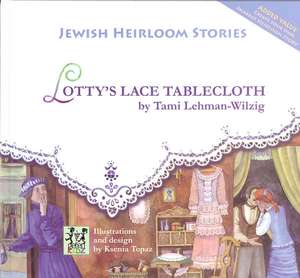Lotty's Lace Tablecloth
Autor Tami Lehman-Wilzigen Limba Engleză Hardback – 19 apr 2007
Preț: 78.62 lei
Preț vechi: 94.86 lei
-17% Nou
Puncte Express: 118
Preț estimativ în valută:
15.04€ • 15.52$ • 12.55£
15.04€ • 15.52$ • 12.55£
Carte indisponibilă temporar
Doresc să fiu notificat când acest titlu va fi disponibil:
Se trimite...
Preluare comenzi: 021 569.72.76
Specificații
ISBN-13: 9789652293688
ISBN-10: 9652293687
Pagini: 32
Ilustrații: illus
Dimensiuni: 221 x 203 x 9 mm
Greutate: 0.27 kg
Editura: Gefen Publishing House
ISBN-10: 9652293687
Pagini: 32
Ilustrații: illus
Dimensiuni: 221 x 203 x 9 mm
Greutate: 0.27 kg
Editura: Gefen Publishing House
Recenzii
"A modern child introduces a story about her great-great-great grandmother, thus linking past and present generations. Lotty is a young lace maker in early 19th-century Vienna. The tablecloth that she designs, makes, and displays in her store window is intended to welcome the Sabbath Queen and is placed on Lotty's Sabbath table every week. But another queen, the Empress Elizabeth, sees it in the shop window and wants it. To allay Lotty's distress over the loss of her beloved lace tablecloth, her husband devises an arrangement with the empress s maid: the empress will use it at her palace receptions on Sundays, and on Fridays she will have it delivered to Lotty to use for the Sabbath. After the empress dies, her daughter returns the cloth to Lotty and it has been handed down in her family ever since. The pleasant, if somewhat far fetched, story is told smoothly, with enough suspense to engage readers and a satisfying ending. Attractive colour illustrations appear on every page, capturing the period atmosphere. The historical setting is developed primarily through the illustrations and no information about the Empress Elizabeth presumably the famous Empress Sisi, wife of Franz Josef, ruler of the Austro-Hungarian Empire is given. Several lined pages follow the story, inviting children to find a Shabbat heirloom in their house, talk about it with their parents and grandparents, and write about how it came into the family. This is the theme of the series: to engage families in enjoyable conversations and activities related to their Jewish heritage. Recommended for grades 2 4, with the caveat that the activity involves writing in the book." -- Inda R Silver, Jewish Valuesfinder, Cleveland, OH, Sept/Oct 2007 issue of the AJL (Association of Jewish Libraries) Newsletter
"A modern child introduces a story about her great-great-great grandmother, thus linking past and present generations. Lotty is a young lace maker in early 19th-century Vienna. The tablecloth that she designs, makes, and displays in her store window is intended to welcome the Sabbath Queen and is placed on Lotty's Sabbath table every week. But another queen, the Empress Elizabeth, sees it in the shop window and wants it. To allay Lotty's distress over the loss of her beloved lace tablecloth, her husband devises an arrangement with the empress s maid: the empress will use it at her palace receptions on Sundays, and on Fridays she will have it delivered to Lotty to use for the Sabbath. After the empress dies, her daughter returns the cloth to Lotty and it has been handed down in her family ever since. The pleasant, if somewhat far fetched, story is told smoothly, with enough suspense to engage readers and a satisfying ending. Attractive colour illustrations appear on every page, capturing the period atmosphere. The historical setting is developed primarily through the illustrations and no information about the Empress Elizabeth presumably the famous Empress Sisi, wife of Franz Josef, ruler of the Austro-Hungarian Empire is given. Several lined pages follow the story, inviting children to find a Shabbat heirloom in their house, talk about it with their parents and grandparents, and write about how it came into the family. This is the theme of the series: to engage families in enjoyable conversations and activities related to their Jewish heritage. Recommended for grades 2 4, with the caveat that the activity involves writing in the book." -- Inda R Silver, Jewish Valuesfinder, Cleveland, OH, Sept/Oct 2007 issue of the AJL (Association of Jewish Libraries) Newsletter
"A modern child introduces a story about her great-great-great grandmother, thus linking past and present generations. Lotty is a young lace maker in early 19th-century Vienna. The tablecloth that she designs, makes, and displays in her store window is intended to welcome the Sabbath Queen and is placed on Lotty's Sabbath table every week. But another queen, the Empress Elizabeth, sees it in the shop window and wants it. To allay Lotty's distress over the loss of her beloved lace tablecloth, her husband devises an arrangement with the empress s maid: the empress will use it at her palace receptions on Sundays, and on Fridays she will have it delivered to Lotty to use for the Sabbath. After the empress dies, her daughter returns the cloth to Lotty and it has been handed down in her family ever since. The pleasant, if somewhat far fetched, story is told smoothly, with enough suspense to engage readers and a satisfying ending. Attractive colour illustrations appear on every page, capturing the period atmosphere. The historical setting is developed primarily through the illustrations and no information about the Empress Elizabeth presumably the famous Empress Sisi, wife of Franz Josef, ruler of the Austro-Hungarian Empire is given. Several lined pages follow the story, inviting children to find a Shabbat heirloom in their house, talk about it with their parents and grandparents, and write about how it came into the family. This is the theme of the series: to engage families in enjoyable conversations and activities related to their Jewish heritage. Recommended for grades 2 4, with the caveat that the activity involves writing in the book." -- Inda R Silver, Jewish Valuesfinder, Cleveland, OH, Sept/Oct 2007 issue of the AJL (Association of Jewish Libraries) Newsletter
